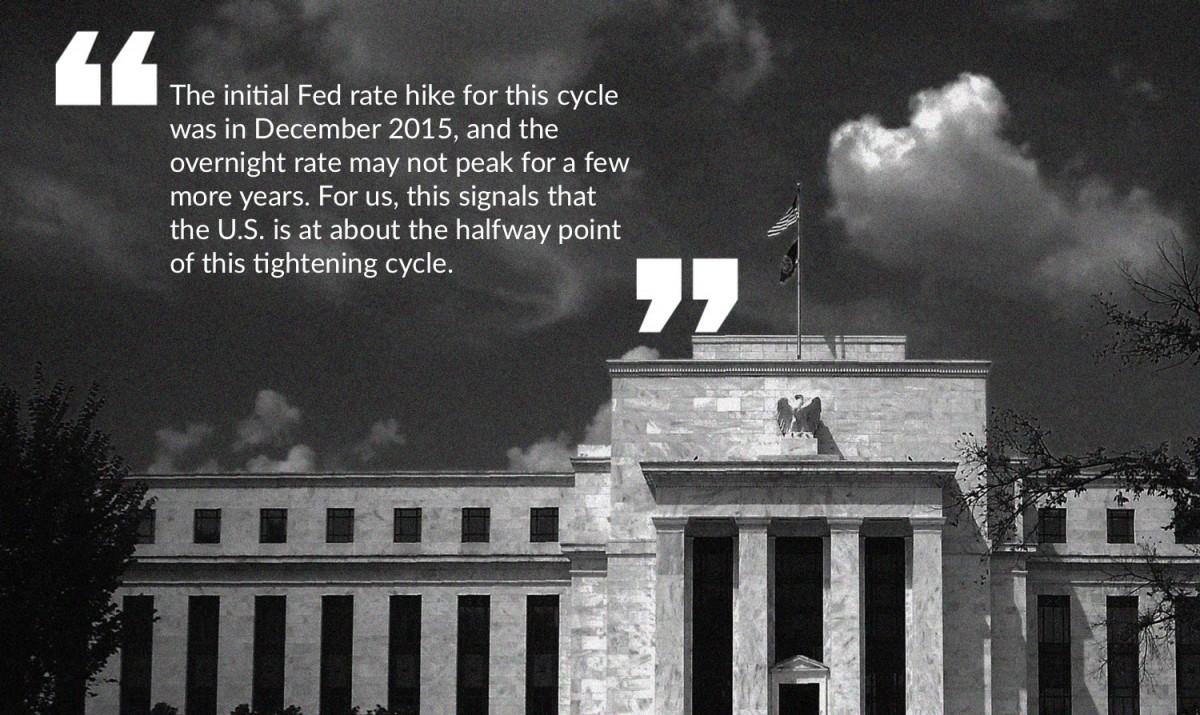Late cycle
investing in
the credit
market
By Marc-André Gaudreau,
Vice President & Portfolio Manager,
1832 Asset Management L.P.
April 17, 2018
Defining the business cycle
In the United States, it is generally accepted that the National Bureau of Economic Research (NBER) is the final arbiter of the dates of the peaks and troughs of the business cycle. An expansion is the period from a trough to a peak, and a recession as the period from a peak to a trough.
The NBER identifies a recession as "a significant decline in economic activity spread across the economy, lasting more than a few months, normally visible in real GDP, real income, employment, industrial production." Business cycles usually last between 4 years and 10 years and the last phase is characterized by Central Banks increasing overnight rates to either slowdown an overheating economy or to fight inflation.

Where are we in the cycle?
Following the Great Recession of 2008, overnight rates were brought down to 0% in the U.S. and the Fed employed quantitative easing in order to stimulate the economy following the housing crisis. As the economy recovered, the need to keep extremely accommodative monetary policies was no longer required and over two years ago, the FED slowly started to tighten them. The recent fiscal stimulus announced by the Trump administration has the potential to boost the U.S. economy over the next two years which is unusual in an expansion phase of a cycle and might push the Fed to further tighten monetary policy.
From a Canadian perspective, our economy could be more impacted than that of the U.S. from higher interest rates due to its over-leveraged consumer.
As such, we believe that we have entered the last phase of the business cycle when the economy is expanding at a strong pace and interest rates are rising. Historically, a recession occurs roughly 4-5 years after the initial Fed rate hike and 1-2 years after the overnight rate has peaked. The initial Fed rate hike for this cycle was in December 2015, and the overnight rate may not peak for a few more years. For us, this signals that the U.S. is at about the halfway point of this tightening cycle. From a Canadian perspective, our economy could be more impacted than that of the U.S. from higher interest rates due to its over-leveraged consumer.
Investment implications
As the Central Banks tighten monetary policies, lower duration securities and solutions can protect portfolios from interest rate movements. Traditional fixed-income solutions could experience periods of negative returns over the next couple of years as interest rates rise. Floating rate securities and solutions should perform well in a rising rate environment. Products such as Dynamic iShares Active Investment Grade Floating Rate ETF invest primarily in high-quality, Canadian corporate bonds and can generate a competitive yield relative to other short-term interest products.
We expect increasing volatility in the markets which makes for a more defensive portfolio positioning in credit as the cycle progresses and the odds of a slowdown increase over the next few years.
We expect increasing volatility in the markets which makes for a more defensive portfolio positioning in credit as the cycle progresses and the odds of a slowdown increase over the next few years. With the right expertise, active credit selection should become even more important in order to find companies that can successfully navigate through a downturn. In Canada, smaller financial institutions should be watched closely as they could negatively be impacted by a housing slowdown.
About Marc-André Gaudreau
Marc-André Gaudreau has over 20 years of industry experience. He joined Dynamic in 2012 as head of the Credit Team, which is responsible for managing over $5 billion in credit-related asset classes including investment grade corporate bonds, preferred shares, high yield bonds and loans, along with floating rate and credit absolute return strategies. Learn more about Marc-André Gaudreau and the recently launched Dynamic iShares Active Investment Grade Floating Rate ETF.
Download PDF
Disclaimer:
*Inclusive of most operating expenses but excludes items such as brokerage expenses and commissions, and taxes. Commissions, management fees and expenses all may be associated with investments in Dynamic iShares Active ETFs. Please read the prospectus before investing. Investments in ETFs are not guaranteed, their values change frequently and past performance may not be repeated. Dynamic Funds® is a registered trademark of its owner, used under license and a division of 1832 Asset Management L.P. Dynamic iShares Active ETFs are managed by BlackRock Asset Management Canada Limited and invest in selected mutual funds managed by 1832 Asset Management L.P. iShares and BlackRock are registered trademarks of BlackRock, Inc., or its subsidiaries in the United States and elsewhere. Used with permission.
